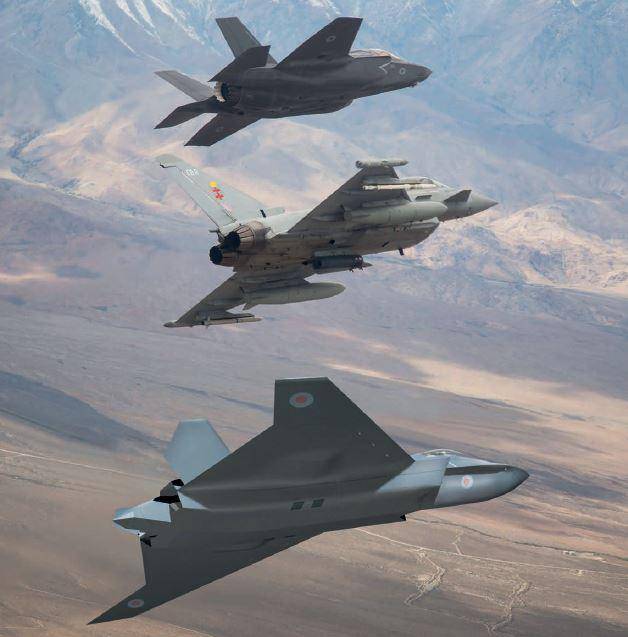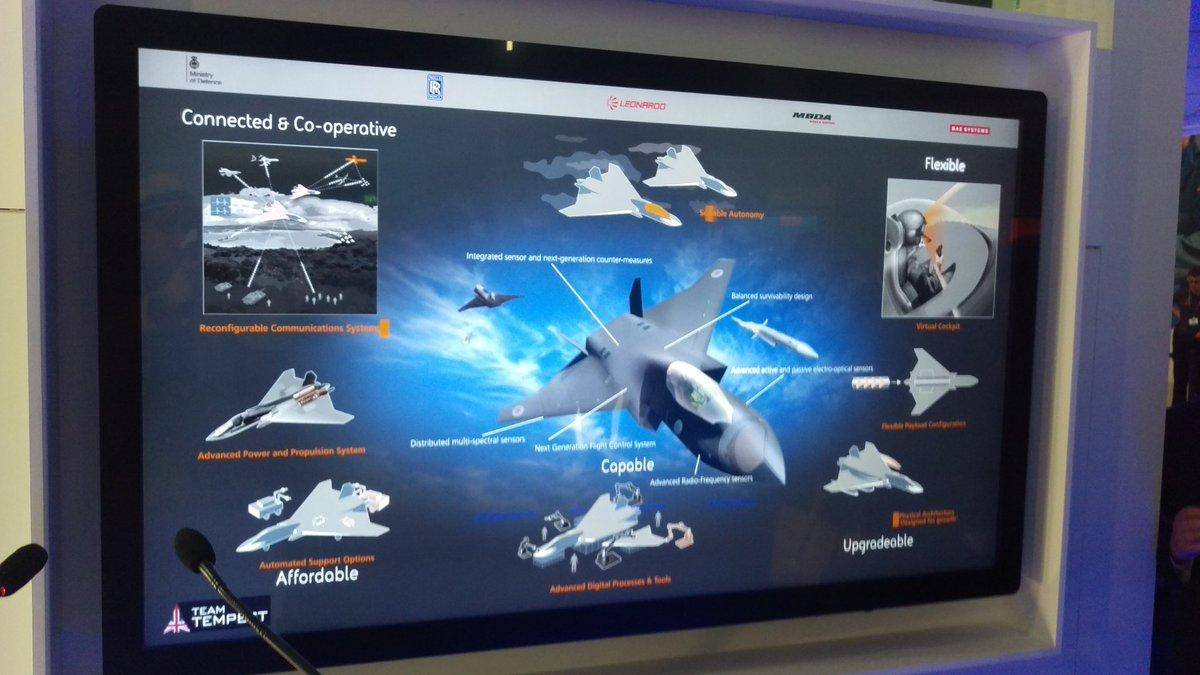The new £2 billion Tempest programme aims to both keep the UK in the combat aircraft business and secure for it a place in the next major European fighter project. Initial mock-ups unveiled with the announcement give some clues about design priorities, but funding the project long term may be challenging
Defence Secretary Gavin Williamson today announced the development of a new combat aircraft intended to eventually replace the Typhoon by the late 2030s or early 2040s, to be developed with European partners. The design phase, designated Tempest after the very successful fighter of the late Second World War, is a central part of the government’s £2 billion Combat Air Strategy, which is intended to run until 2025. A physical mock up of the Tempest was unveiled for the announcement at the Farnborough Air Show, along with virtual concept art, with both showing a fairly large fighter with design features reminiscent of current stealth fighters such as the American F-22 and F-35, and the Chinese J-20A. The virtual and physical mock-ups followed a common theme, although there are various minor differences between the shapes. This strongly suggests that the airframe shapes shown off are merely early concepts rather than anything approaching technology demonstrators such as the BAE Systems Taranis or the EAP Demonstrator, which preceded the Eurofighter Typhoon. However, the common features of the various concepts shown do give clues about current British thinking on what the next generation of combat aircraft might look like.
The various artworks and the demonstrator model all includes canted vertical stabilisers, which are a feature on all currently operational fighter aircraft, but not the US Air Force’s famous B-2 Spirit stealth bomber, or various flying wing/cranked kite shapes that have come to characterise unmanned combat aerial vehicle (UCAV) demonstrators produced around the world, including Taranis, nEUROn, Sharp Sword, SCAT and X-47B. Vertical stabilisers indicate a design preference for fighter-like agility since they aid horizontal stability during manoeuvres, especially in extreme flight regimes. However, they also limit the extent to which an aircraft’s radar signature can be reduced, especially against low-frequency ‘anti-stealth’ type radars. Because of this, and the fact that some argue the agility of modern missiles make dogfighting redundant in future air combat, most concept art from US defence companies in recent years have not included vertical stabilisers, presumably to aid stealth against advanced and future radar systems.

The Tempest concepts also all feature a longer, wider fuselage than the F-35, which would improve the internal fuel load and allow more space for weapons bays and other internal sensor and/or combat payloads that might include the capacitors and coolant required for laser weaponry. Twin engines with divertless supersonic intakes are also included, which would allow improved performance especially at high altitude compared to the F-35’s single engine design. These design features point to an preference of endurance and unrefuelled range over low costs and simplicity, as well as sufficient internal space and weight capacity to allow for the insertion of future modular payloads internally. They also suggest that there is no intention to make a new combat aircraft capable of operating on the new Queen Elizabeth Class aircraft carriers since the design is very clearly not compatible with short take-off, vertical landing (STOVL) capabilities. There is a, perhaps surprising, degree of similarity in design approach between these initial concepts for the UK’s new Tempest and the design choices made by the Chengdu aircraft company that builds China’s new stealthy J-20A. Both are large, twin-engined fighters with small canted vertical surfaces and strong design influences from the American F-22 Raptor, evident around the nose and cockpit, which are critical for signature reduction.

The Tempest will supposedly be flyable by a pilot in the cockpit or capable of operating as a drone – an arrangement known as ‘optionally manned’ in aviation circles. However, most of the design advantages gained by eliminating the need for an onboard crew are clearly lost in an optionally manned design. It still requires a cockpit, life support systems, physical controls and an instrumentation/information display system for the pilot, all of which add weight, complexity, reduce the space available for fuel, weapons and sensors, and the need for a canopy fairing limits how stealthy the airframe can be made. Perhaps more importantly, if pilots are to be trained for the Tempest, this will require expensive peacetime flying to train and maintain pilot proficiency. The fact that a UCAV can, in theory, stay on the ground, with operators trained simply with simulated aircraft except during actual operational missions, is a key potential cost-saving feature of unmanned alternatives to fast jets, but this would be largely lost with an optionally manned type. On the other hand, while the ability to fly high-risk missions unmanned, to reduce the risk to human pilots, is theoretically useful, the extra electronic complexity and programming risk needed to develop a combat aircraft capable of operating in complex and contested environments without a pilot on board is still required.
The Combat Air Strategy, as a £2 billion pool of funding earmarked to demonstrate that the UK is serious about developing a new aircraft and starting negotiations with potential European partner nations for a joint programme, is a promising start. It is also critical to help convince British aerospace industries that the combat air sector is still a viable place to invest in future capability and skills. However, even with strong support from Italy’s Leonardo as well as other potential partners, especially France, Sweden and Germany, it will take a lot more than £2 billion to develop an actual combat aircraft from the Tempest project in time to replace Typhoon in the starting in the late 2030s.
The Typhoon programme cost the UK around £17 billion in development and acquisition costs for 160 aircraft. Tempest promises to be an even more ambitious undertaking, despite the progress made in various critical technologies in both the defence and civilian sectors since the 1980s when Typhoon was conceived. Assuming no major uplift in defence spending, the RAF and MoD will have to find significant funding within the equipment programme for the Tempest project if it is to have any hope of producing a real combat aircraft. Unfortunately, that is likely to be very difficult without adjusting the number of F-35s that the UK will eventually buy from the US, given that the continued public commitment to 138 of the stealth fighters will not be delivered on current funding timelines until the late 2030s at the earliest. Based on current defence spending assumptions, it is unlikely that the MoD will be able to adequately fund the testing and procurement phases of the Tempest while buying significant numbers of F-35s and maintaining an increasingly aging core Typhoon force as the latter approaches its eventual out of service date of approximately 2040. Something will eventually have to give.
The difficulty for now is that the United States Air Force in particular has bet everything on the success of the F-35A and the combined efforts of Lockheed Martin, the Pentagon and overseas partners to drive the costs of that aircraft down to a level where it can buy enough to replace its huge legacy F-16 and F-15 fleets. An admission by the UK that it does not plan to buy all 138 jets would have a knock-on effect on unit costs for the whole F-35 programme at a sensitive time. Equally, US President Donald Trump is keenly protective of US exports and would take any UK reduction in F-35 orders as a serious slight at a sensitive time in the search for post-Brexit trade deals. Nonetheless, if the UK wishes to stay in the combat aircraft business as a major player, then it simply must start development of a new aircraft to keep its industrial base in the game. The announcement by the defence secretary may well do just that, but the government must now pull off a balancing act to explain the long term financial viability of Tempest to industry and potential partners while maintaining its commitment to purchase 138 F-35s to the United States.
Justin Bronk
Research Fellow for Airpower and Military Technology, RUSI
WRITTEN BY
Justin Bronk
Senior Research Fellow, Airpower & Technology
Military Sciences


